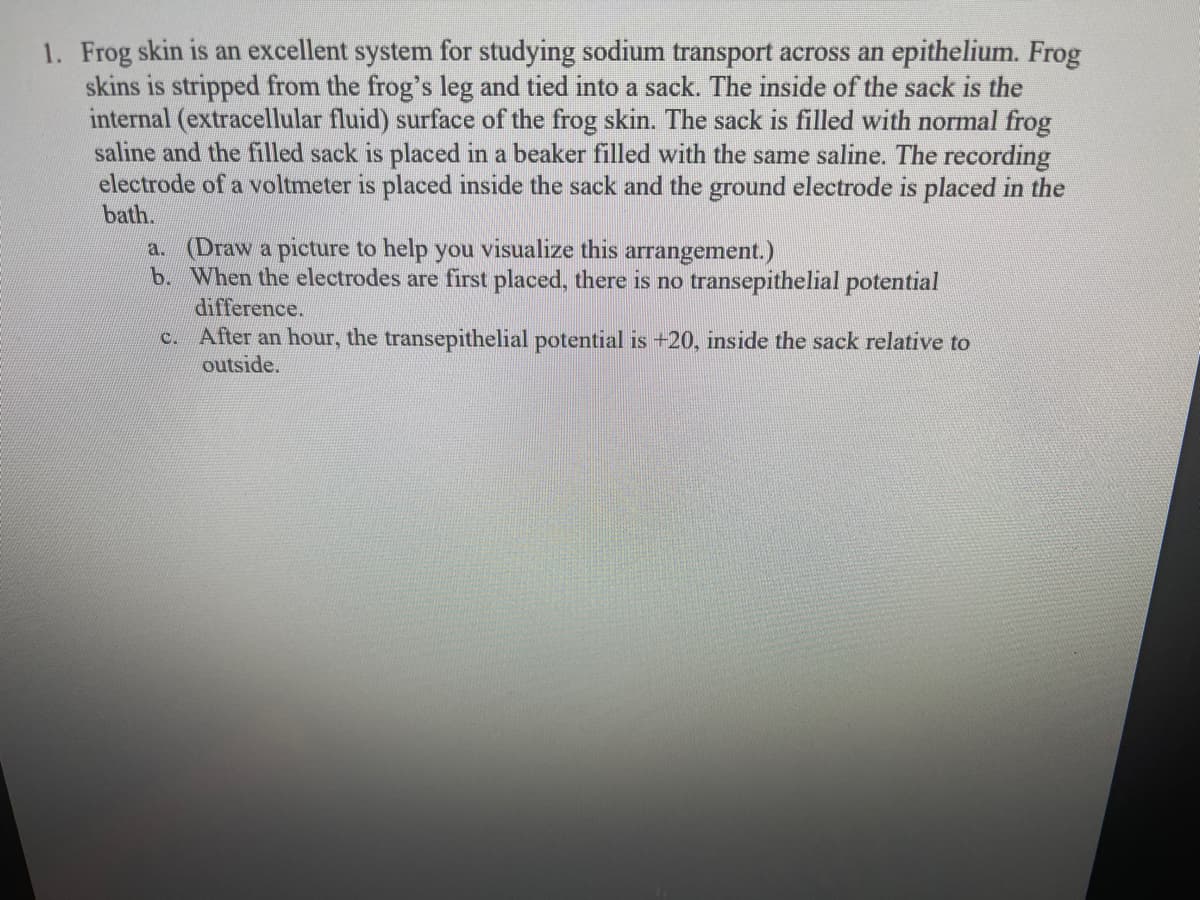1. Frog skin is an excellent system for studying sodium transport across an epithelium. Frog skins is stripped from the frog's leg and tied into a sack. The inside of the sack is the internal (extracellular fluid) surface of the frog skin. The sack is filled with normal frog saline and the filled sack is placed in a beaker filled with the same saline. The recording electrode of a voltmeter is placed inside the sack and the ground electrode is placed in the bath. a. (Draw a picture to help you visualize this arrangement.) b. When the electrodes are first placed, there is no transepithelial potential difference. c. After an hour, the transepithelial potential is +20, inside the sack relative to outside.
1. Frog skin is an excellent system for studying sodium transport across an epithelium. Frog skins is stripped from the frog's leg and tied into a sack. The inside of the sack is the internal (extracellular fluid) surface of the frog skin. The sack is filled with normal frog saline and the filled sack is placed in a beaker filled with the same saline. The recording electrode of a voltmeter is placed inside the sack and the ground electrode is placed in the bath. a. (Draw a picture to help you visualize this arrangement.) b. When the electrodes are first placed, there is no transepithelial potential difference. c. After an hour, the transepithelial potential is +20, inside the sack relative to outside.
Biology: The Dynamic Science (MindTap Course List)
4th Edition
ISBN:9781305389892
Author:Peter J. Russell, Paul E. Hertz, Beverly McMillan
Publisher:Peter J. Russell, Paul E. Hertz, Beverly McMillan
Chapter48: Regulating The Internal Environment
Section: Chapter Questions
Problem 2TYK
Related questions
Question

Transcribed Image Text:1. Frog skin is an excellent system for studying sodium transport across an epithelium. Frog
skins is stripped from the frog's leg and tied into a sack. The inside of the sack is the
internal (extracellular fluid) surface of the frog skin. The sack is filled with normal frog
saline and the filled sack is placed in a beaker filled with the same saline. The recording
electrode of a voltmeter is placed inside the sack and the ground electrode is placed in the
bath.
a. (Draw a picture to help you visualize this arrangement.)
b. When the electrodes are first placed, there is no transepithelial potential
difference.
c. After an hour, the transepithelial potential is +20, inside the sack relative to
outside.
Expert Solution
This question has been solved!
Explore an expertly crafted, step-by-step solution for a thorough understanding of key concepts.
Step by step
Solved in 3 steps with 2 images

Knowledge Booster
Learn more about
Need a deep-dive on the concept behind this application? Look no further. Learn more about this topic, biology and related others by exploring similar questions and additional content below.Recommended textbooks for you

Biology: The Dynamic Science (MindTap Course List)
Biology
ISBN:
9781305389892
Author:
Peter J. Russell, Paul E. Hertz, Beverly McMillan
Publisher:
Cengage Learning

Biology 2e
Biology
ISBN:
9781947172517
Author:
Matthew Douglas, Jung Choi, Mary Ann Clark
Publisher:
OpenStax

Biology: The Dynamic Science (MindTap Course List)
Biology
ISBN:
9781305389892
Author:
Peter J. Russell, Paul E. Hertz, Beverly McMillan
Publisher:
Cengage Learning

Biology 2e
Biology
ISBN:
9781947172517
Author:
Matthew Douglas, Jung Choi, Mary Ann Clark
Publisher:
OpenStax